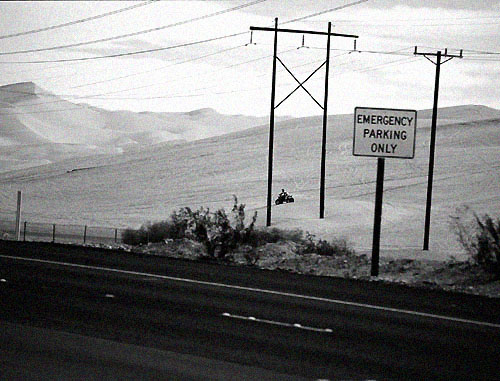A long time ago I started work on a concept called threadneedle, a way to track threads of communication through weblogging. However, when Movable Type introduced the concept of Trackback, I dropped work on Threadneedle because Trackback provided much of the functionality I was hoping for from the original concept.
I loved Trackback. Now when you go to a site, not only can you read comments associated with a writing, you can see who linked to the writing from their own efforts. A little bit of extra functionality and you could follow a ladder of links, hopping from node to node following the conversation through many, many generations. Trackback was my friend.
Trackback is now my enemy.
I received several hundred pings with one of my posts today, courtesy of our favorite crapflooder. The link he used as the source weblog for the entry was from a weblogger who had managed to close this person down at his server. The person was pissed. However, the weblogger who had pissed off our crapflooder had protections in place to stop our friend from slamming him, so he went elsewhere.
Here.
Since the crapflooder, who goes by Dv, couldn’t punish the other weblogger, Geoffrey, he punished me instead.
(You can see a conversation between these two in my comments, starting here. Should delete them, I suppose. It’s become kind of a fascinating study though.)
(Before you even think about putting anything in my comments about IP address, be aware that we’ve gone beyond one static IP a long time ago. No, this person used a proxy to get IP addresses, and the pings originated from many different addresses. )
There are some people who have been working this problem. I’ll link one that I know has Trackback filtering, Jacques Distler (I’m not sure if the other people have Trackback throttling yet so I won’t link them for that reason, not to exclude them). There are no easy solutions to this problem, except for having to break into the Movable Type perl modules in order to add or alter code.
Well, I am comfortable with Perl. However, I am hesitant to make the number of changes to the number of modules and templates in order to get this working. More importantly, though, is that this solution puts the non-techs at a real disadvantage. If they copy modules right and left, one from mt-blacklist here, another for trackback throttling there, when MT 3.0 comes out, they are basically going to have one miserable time upgrading. It is becoming a mess.
Now, I can still make changes and tell the non-techs to ‘wing it’ for now.
“This here is where we separate the Men from the Boys, pardner.”
*ptoi*
“Yessiree Bob. Now we gonna know who got Code, and who don’t. And everyman for hisself.”
*ptoi*
“And, hee, hee, hee, hee, if you little ladies ask real nice, why, I might come over and give you a hand. Hee, hee, hee. If you know what I mean.”
*ptoi*
Well, of course that’s not how it is, other than I’ve been dying to write a scene like that for just forever. No, the technical folks around here are more than willing to share code, and provide help – but they can only do so much. They can’t help every non-tech weblogger who is using Trackback. Not and have any kind of a life.
We need one set of code, one set of fixes, packaged so that all the non-techs have to do is copy the files into their folders.
Of course, while waiting for this event, I am a target and it makes sense for me to make the change regardless of other folks. The problem though is our friend, Dv. You see, the weblogger who’s tangled with Dv told me that if he can’t go for you, he’ll go for someone else connected to you. How does someone connect to you? Well, through Trackback, of course.
So I make a change to throttle the Trackback, and you innocently enough Trackback to one of my posts; you’ve just put yourself right into that big red bullseye.
Of course, Dv probably will get tired eventually and move on, but I’m not going to take that chance. The only alternative I have is to turn Trackbacks off for all my posts. Until there’s a formal fix packaged for distribution that can be applied by techs and non-techs alike, to all intents and purposes, Trackback is broke.
But then, all it’s doing is following the path set by it’s cousin. I’ve been out and about this week, and let’s face it – comments are a mess. I’ve seen sites that use a visual indicator you have to type in exactly or the post won’t go through. This stops the auto-spamming. Unfortunately, it also stops people with visual impairment.
Others are using mt-blacklist, or some version of 2.661, but now these are becoming hacked together, and the code is beginning to resemble what’s left of two cars driven into each other at very fast speeds. But at least it’s easy to tell if you’re running 2.661 – you get this redirect page when you click on the URL. That’s so the comment spammers don’t get Google juice.
But that was yesterday’s problem. What new problem do you have for me today?
I think we’re all getting tired. I was tired earlier this week, but I felt like I’d let people down not keeping up the good fight. But now, I think I have a lot of company. I’m sorry, but there’s no graceful and politically correct way to say this: This is fucking ridiculous.
When I was 19, I roomed with another woman in an apartment in Kirkland, Washington. I ended up going out with one of the guys next door who had just broken up with his girlfriend.
One day, a group of us, a small group, were sitting around drinking beers and making plans for a boat race the following weekend. There was a knock at the door, and when we opened it, two cops entered the apartment. They’d had a call that a wild party was going on in the apartment, and we were all using dope.
Of course, the cops could see that no wild party was going on, and there was no evidence of drug use. In fact, one even said that they wondered if they had the right apartment because it was so quiet when they came to the door. They did a quick look around, apologized, and left.
Years later, I found out that the cops had been called by my boyfriend’s ex-girlfriend, anonymously. I found out because she’d bragged to one of her friends about it.
What does this have to do with the problem? Not a damn thing, other than when Dv hit today for some reason I was reminded of my boyfriend’s ex and the call to the cops.

